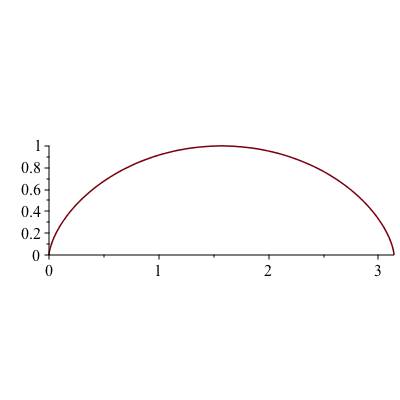Brachistochrone Problem: Find the shape of the curve down which a bead sliding from rest and accelerated by gravity will slip from on point to another in the least time. Here, we do not consider friction.
Due to conservation of energy, we have
\begin{equation}
\label{eq:energy}
\frac{1}{2}mv^2=mgy
\end{equation}
Solving \eqref{eq:energy} for the speed $v$, we obtain
$$v=\sqrt{2gy}$$
The time $T_{PQ}$ for the bead to travel from a point $P$ to $Q$ is
\begin{align*}t_{PQ}&=\int_P^Q\frac{ds}{v}\\&=\int_P^Q\frac{\sqrt{dx^2+dy^2}}{\sqrt{2gy}}\\&=\int_P^Q\sqrt{\frac{1+y_x^2}{2gy}} \end{align*}
Let $f(y_x,y)=\sqrt{\frac{1+y_x^2}{2gy}}$. The path from $P$ to $Q$ which minimizes $t_{PQ}$ can be found by solving the Euler-Lagrange equation ([1])
\begin{equation}
\label{eq:E-L}
\frac{\partial f}{\partial y}-\frac{d}{dx}\frac{\partial f}{\partial y_x}=0
\end{equation}
It can be easily shown that \eqref{eq:E-L} is equivalent to
\begin{equation}
\label{eq:E-L2}
\frac{\partial f}{\partial x}-\frac{d}{dx}\left(f-y_x\frac{\partial f}{\partial y_x}\right)=0
\end{equation}
Since $f$ does not explicitly depend on $x$, $\frac{\partial f}{\partial x}=0$, so from \eqref{eq:E-L2}, this leads to
$$f-y_x\frac{\partial f}{\partial y_x}=C$$
for some constant $C$. On the other hand, we have
$$f-y_x\frac{\partial f}{\partial y_x}=\frac{1}{\sqrt{2gy(1+y_x^2)}}$$
Hence, we arrive at the differential equation
$$\frac{dy}{dx}=\sqrt{\frac{k^2-y}{y}}$$
where $k^2=\frac{1}{2gC^2}$. The differential equation is separable and it can be written as
\begin{equation}
\label{eq:de}
\sqrt{\frac{y}{k^2-y}}dy=dx
\end{equation}
Let $\sqrt{\frac{y}{k^2-y}}=\tan\frac{\theta}{2}$. Then
$$y=k^2\sin^2\frac{\theta}{2}=\frac{1}{2}k^2(1-\cos\theta)$$
The equation \eqref{eq:de} becomes
$$k^2\sin^2\frac{\theta}{2}d\theta=dx$$
Integrating both sides with the half-angle formula $\sin^2\frac{\theta}{2}=\frac{1-\cos\theta}{2}$, we obtain
$$x=\frac{1}{2}k^2(\theta-\sin\theta)+C_1$$
for some constant $C_1$. With the condition $P(0,0)$, i.e. $x=y=0$ when $\theta=0$, we have $C_1=0$ and so,
$$x=\frac{1}{2}k^2(\theta-\sin\theta)$$
Therefore, the curve on which the bead is sliding down in the shortest time is a cycloid given by the parametric equations
\begin{align*}x&=\frac{1}{2}k^2(\theta-\sin\theta)\\y&=\frac{1}{2}k^2(1-\cos\theta)\end{align*}
In geometry, a cycloid is the curve traced by a point on a circle as it rolls along a straight line without slipping.

References:
- George Arfken, Mathematical Methods for Physicists, Third Edition, Academic Press, 1985
